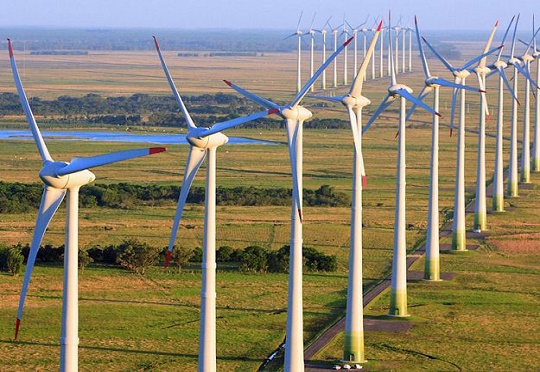An analysis of global electricity revealed that wind and solar showed resilient growth in 2020 despite the pandemic, forcing a record fall in global coal power.
The Global Electricity Review published by energy think tank Ember analysed electricity data from every country in the world to give the first accurate view of the global electricity transition in 2020.
It revealed that almost a tenth of global electricity was generated by wind and solar in 2020. Morocco and Kenya are the clear leaders in Africa, already ahead of the world average. However, data from 2014 to 2019 shows that only a third of the rise in Africa’s electricity demand was met with renewables, and two-thirds of the rise was met with fossil gas.
2020 global power trends: Pandemic pause helps wind and solar push coal to a record fall
The pandemic brought the world to a halt in 2020 and paused the world’s rising demand for electricity. The slight drop in demand (-0.1%) was the first fall since 2009, although it was smaller than the impact of the financial crisis.
Wind and solar power showed resilient global growth in 2020 despite the pandemic, up by 15% (+314 TWh) versus 2019. The growth in wind and solar helped push coal power to a record fall of 4% (-346 TWh).
Global wind and solar boom, Morocco and Kenya lead the way in Africa
Globally wind and solar doubled in the last five years to supply almost a tenth of global electricity in 2020. Among Africa’s leading economies, Morocco and Kenya had the highest levels of wind and solar, respectively generating 16% and 15% of their electricity from wind and solar in 2019.
Morocco has achieved a rapid increase in solar power, increasing from near-zero in 2015 to 4% of its electricity in 2019. It also increased its wind power from 9% of its electricity in 2015 to 12% in 2019. Kenya has seen a rapid acceleration in wind power, increasing from less than 1% in 2015 to 14% in 2019. Solar power remains at less than 1% of Kenya’s electricity.
Many of Africa’s leading economies have yet to harness the potential of wind and solar power, which are now amongst the cheapest forms of new electricity. In 2019, Nigeria and Algeria generated less than 1% of their electricity from wind and solar, while Egypt increased to 3% in 2019 after recent growth in solar power. South Africa generated 6% of its electricity from wind and solar in 2020, tripling since 2015, but still below the world average of 9.4%.
Across the G20, many countries mirrored the global average wind and solar share (9.4%) in 2020, including India (9%), China (9.5%), Japan (10%), Brazil (11%), the US (12%) and Turkey (12%). Europe is leading the way, with Germany at 33% and the United Kingdom at 29%, giving confidence in how wind and solar can be quickly built and integrated into the electricity system.
Emerging economies such as India and Turkey have accelerated their deployment of wind and solar to reduce their dependence on fossil fuels. India’s wind and solar generation tripled in five years to provide 8.9% of total electricity production in 2020, now just below the global average. Lower electricity demand and wind and solar growth led to coal’s market share falling by 5% since 2015.
In Turkey, wind and solar provided 12% of electricity generation in 2020, this share has tripled since 2015. This helped to reduce gas and oil’s market share by 11% over the same period, however coal’s market share continued to grow.
Fossil fuels still dominate the world’s electricity in 2020
Fossil fuels generated 61% of the world’s electricity in 2020, down from 66% in 2015 when the Paris Agreement was signed. Coal was the single largest source, responsible for 34% of global electricity in 2020.
The dataset of global electricity generation revealed that major African economies were significantly more reliant on fossil fuels for electricity than the world average of 61%. Above-average levels of fossil fuels were observed in Nigeria (81%) and South Africa (89%) in 2020, also in Egypt (90%), Algeria (99%) and Morocco (79%) in 2019. South Africa stands out with by far the largest share of coal (86%) in Africa, over double the world average.
However, fossil fuel’s share of electricity is hugely varied across Africa, as many countries have far higher shares of clean electricity than the world average in 2020 (39%). Ethiopia, Kenya, Angola and Zambia all generated over 80% of their electricity from clean sources in 2019. Kenya recently pledged 100% renewable electricity by 2030, showing their commitment to a clean energy future.
Across the G20 there were also many countries with fossil fuel shares above the global average in 2020. Five G20 countries had over three-quarters of their electricity supplied from fossil fuels in 2020: Saudi Arabia (100%), South Africa (89%), Indonesia (83%), Mexico (75%) and Australia (75%). In comparison, France and Brazil only generated 9% and 14% of their electricity from fossil fuels, respectively.
Africa’s rising electricity production
In Africa, electricity production is still increasing every year. From 2014 to 2019, renewables met one third of Africa’s growth in production, with gas making up the remaining two thirds.
Renewables growth in Africa has been accelerating since 2015, but it has not yet been fast enough to meet all of the rising demand. The rise in gas was particularly marked in North Africa, where there were the biggest increases in electricity demand, and very little build-up of renewable electricity.
Africa – unlike Asia – has avoided a coal-reliant electricity grid. There has been no growth in total coal generation since 2014, as South Africa’s falling coal generation was cancelled out by increases in Morocco and Zambia. In addition, there is very little coal capacity under construction or planned in Africa – only South Africa and Zimbabwe are building new coal.
The full report can be accessed below:














